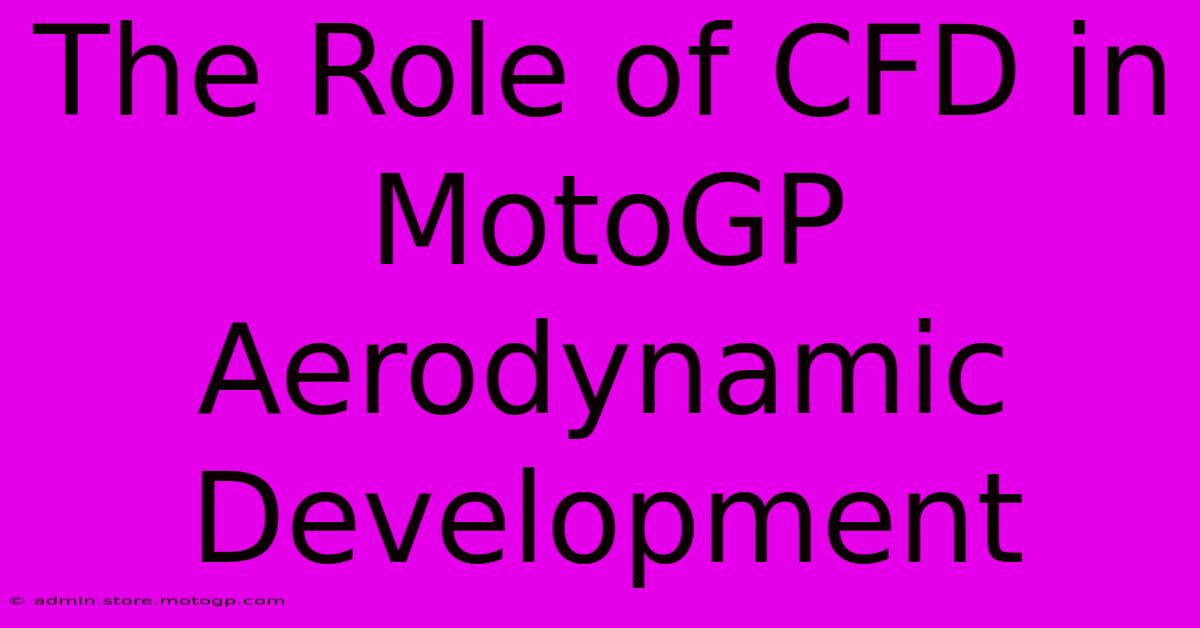The Role Of CFD In MotoGP Aerodynamic Development

Table of Contents
The Role of CFD in MotoGP Aerodynamic Development
The roar of the engines, the lean of the bikes, the breathtaking speeds—MotoGP is a spectacle of precision engineering and daring skill. Behind the thrilling races lies a relentless pursuit of performance, and a crucial element in this quest is aerodynamic optimization. Computational Fluid Dynamics (CFD) has become an indispensable tool, revolutionizing how teams design and develop the aerodynamic packages of their MotoGP machines.
Understanding the Importance of Aerodynamics in MotoGP
MotoGP bikes operate at extreme speeds, generating significant downforce and drag. Aerodynamics play a critical role in several key aspects:
- Cornering Speed: Downforce keeps the bike glued to the track, allowing riders to maintain higher speeds through corners, significantly impacting lap times.
- Stability: Aerodynamic balance is crucial for stability at high speeds, preventing unwanted wheelies or slides.
- Braking Performance: Aerodynamic downforce assists in braking, shortening braking distances and improving overall lap times.
- Fuel Efficiency: Reducing drag improves fuel efficiency, allowing teams to potentially run lighter fuel loads.
How CFD Contributes to Aerodynamic Development
CFD uses sophisticated software to simulate airflow around the motorcycle. By creating a virtual wind tunnel, teams can:
- Analyze Airflow Patterns: CFD allows engineers to visualize and analyze airflow patterns in unprecedented detail, identifying areas of high pressure and low pressure, drag, and lift.
- Design and Optimize Components: Engineers can test various aerodynamic components (wings, fairings, spoilers) virtually, evaluating their performance before physical prototyping. This process significantly reduces development time and costs.
- Explore Design Variations: CFD facilitates the rapid exploration of numerous design iterations, enabling teams to optimize shapes and angles for maximum downforce and minimal drag.
- Reduce Wind Tunnel Testing: Although wind tunnels remain important, CFD significantly reduces the reliance on expensive and time-consuming wind tunnel testing, allowing for more efficient use of resources.
Specific Applications of CFD in MotoGP Aerodynamics:
- Wing Design: CFD is instrumental in optimizing the shape, size, and angle of wings to maximize downforce while minimizing drag. Teams use CFD to fine-tune wing profiles for specific tracks and conditions.
- Fairing Design: The fairing's shape is crucial for directing airflow around the rider and machine. CFD helps optimize fairing designs for minimal drag and efficient airflow management.
- Rider Interaction: The rider's position and movements affect the airflow. CFD helps assess the aerodynamic impact of rider posture and movement, allowing teams to optimize rider ergonomics and improve aerodynamic efficiency.
The Advantages of CFD in MotoGP Aerodynamic Development:
- Cost-Effectiveness: Reduces the need for extensive physical prototyping and wind tunnel testing, saving considerable time and money.
- Speed and Efficiency: Allows for rapid iteration and optimization of designs, accelerating the development process.
- Detailed Analysis: Provides in-depth data and visualizations, offering a level of insight impossible to achieve through traditional methods.
- Improved Performance: Ultimately leads to improved aerodynamic performance, resulting in faster lap times and enhanced competitiveness.
The Future of CFD in MotoGP
As computing power continues to increase, CFD simulations will become even more sophisticated and accurate. We can expect to see even more refined aerodynamic packages on MotoGP bikes in the years to come, pushing the boundaries of performance further. The integration of machine learning and AI with CFD is also likely to revolutionize the process, automating design optimization and accelerating the development cycle even further. The relentless pursuit of speed in MotoGP will undoubtedly continue to drive innovation in CFD technology.
In conclusion, CFD has transformed aerodynamic development in MotoGP, enabling teams to achieve levels of performance previously unimaginable. This powerful technology is not just a tool; it's a crucial element in the ongoing battle for supremacy on the track.

Thank you for visiting our website wich cover about The Role Of CFD In MotoGP Aerodynamic Development. We hope the information provided has been useful to you. Feel free to contact us if you have any questions or need further assistance. See you next time and dont miss to bookmark.
Featured Posts
-
Circuit Of The Americas Parking Where To Park And What To Expect
Feb 20, 2025
-
Motorcycle Race Bikes For Sale Performance Enhanced
Feb 20, 2025
-
Unlocking The Secrets Of The Moto Gp Points System
Feb 20, 2025
-
Moto Gp Points System Your Guide To Understanding The Sport
Feb 20, 2025
-
Moto Gp Speed Demons How They Achieve Top Speed
Feb 20, 2025
